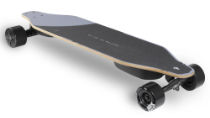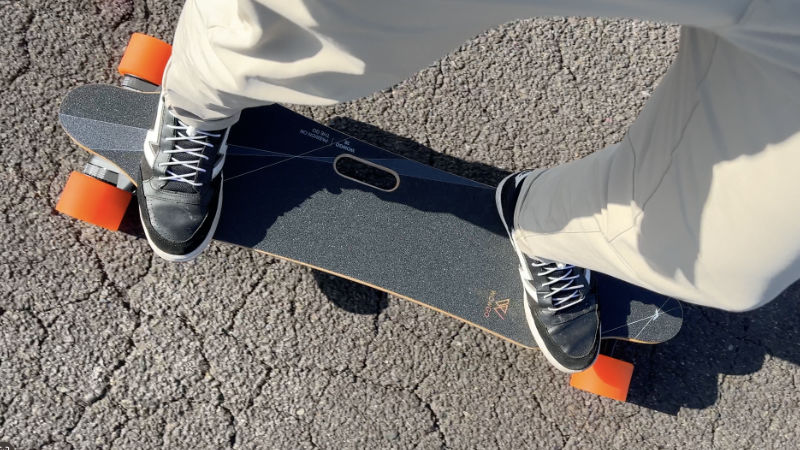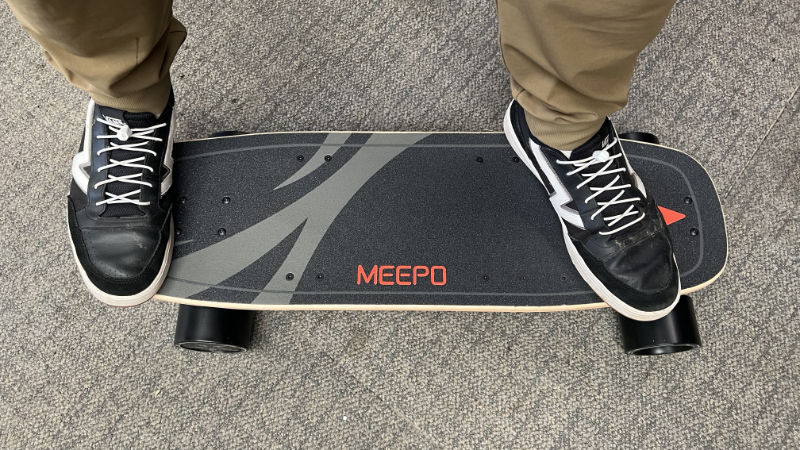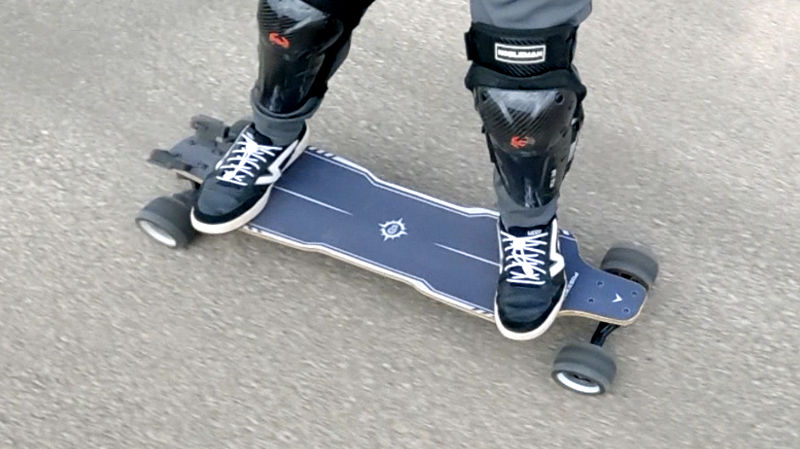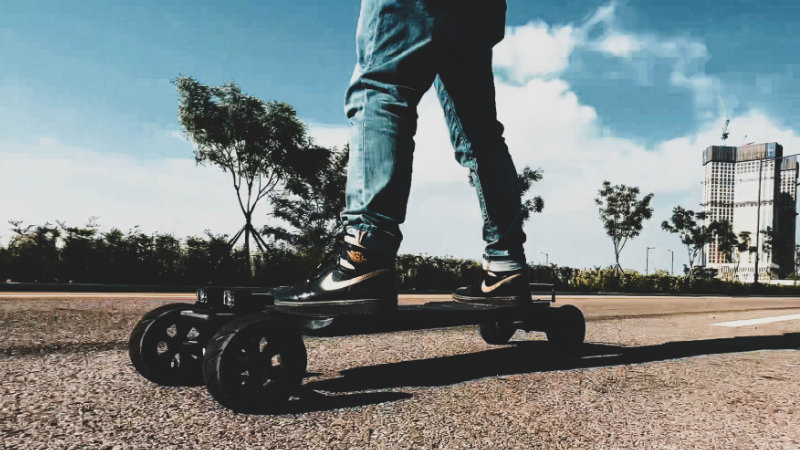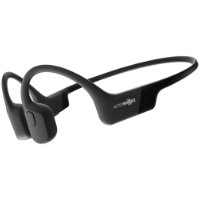Watch:
The Uditer W3 is an electric skateboard with handlebars.
The idea is to make electric skateboarding easier for beginners to learn on and to also provide content creators somewhere to mount their cameras.
Uditer is a fairly new company who I don’t really know much about.
Their YouTube channel’s oldest video is from Decemeber 2020, so they haven’t been around for long.
Yet, they already have 4 different electric skateboard products.
The line up is a bit confusing, so let me try to break it down for you.

There is the 3 series which is what I’ll be reviewing today, the 3 Pro series, the Mini and the Evo.
The 3 series has Hub motors, while the 3 Pro has belt-motors. That’s the ONLY difference between the two.
You’ll see that for each of the 3 and 3 Pro there is one labelled S and one labelled W. The only difference here is the deck shape. The both have the exact same electronics.
Why they decided to split them into two different products and not just make it a variation that you can select, is beyond me.
The Mini, as the name suggests, is the shortboard version and it also has a slightly smaller battery pack, everything else is the same as the 3 series.
Finally, the EVO is intended to be the AT model. It has Urban-terrain wheels, wider double-kingpin trucks and bigger 1500W motors. It uses the same battery as the 3 and 3 Pro.
Uditer position themselves as the first, creative, transformable electric skateboard.
Creative, because they are aiming to target the vloggers out there.
They have an accessory that allows you to mount a camera such as a GoPro, Insta360 or any other compatible camera directly to your board.
They also offer a handlebar extension so you can transform your electric skateboard into a scooterboard.
I’ll show you how each of these accessories work and whether or not they are actually worth it later on in the review, but first, let’s do the performance tests!
Range Test
The Uditer boards are touted as long range electric skateboards and Uditer claim they can get between 35-40km (22-25 miles) in a single charge.
On my very first ride my range was waaay below the marketed range.
This is the ride where I do ALL of my tests, including the top speed test and hill climb test and I also do a fair bit of carving. I pretty much ride the eboard as hard as I can.
On this particular day, there was also quite a a bit of wind
After all that, I only ended up getting 21.8km which is 13.5 miles.
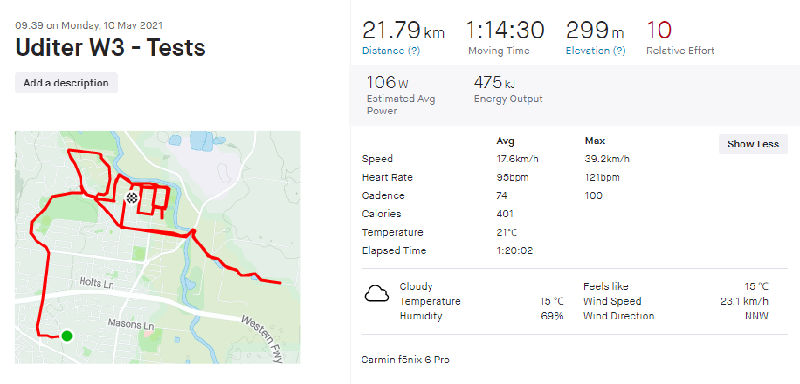
That is a very disappointing figure, so I contacted Spike to let him know of my results, and his reply was;
“It’s impossible. Do it again.”
So, I did.
This time, I rode on completely flat, smooth paths along the coast. There was a lot less wind and I dropped my average riding pace, never going faster than 27kph.
All of this got me a total range of 28.1km which is 17.5 miles.
That’s a 30% increase which shouldn’t be understated. Simply changing some conditions netted in a fairly significant increase in range.
Spike from Uditer told me that they tested the range capability with a 70kg rider, so me being 90kg definitely plays a role in me not hitting the specced range.
Do I think 40km or 25 miles is possible?
I would say yes, if the conditions were right.
A 70kg rider, riding at a steady pace of about 20kph, without too much stopping and starting on perfectly smooth and flat paths with zero wind.
That will do the trick.
At least now we can all see how much of an affect different conditions have on the range. Hopefully it gives you a good starting point to estimate what range you might be able to get.

Top Speed Test
The marketed top speed of the Uditer W3 and S3 is 45kph which is 28mph.
However, in my testing I was only able to hit a max of 39kph which is 24mph.
I was only a few marks off the pace, so I would say that lighter riders will be able to hit the specced speed.

Acceleration Test
The acceleration on the Uditer W3 is very gradual. Even in the top speed mode, going from a stand-still to full throttle, I never felt like it had the potential to throw me off.
For 99% of the ride, there isn’t any jolting in the acceleration.
That 1% however, occurs at the very end of the battery life.
I’d say 5 minutes off from a dead battery, the throttle starts to get this very slight jerking when you try to accelerate.
It’s not much and hardly a hinderance to your ride.
I thought I’d better mention it, because for beginners, it might be a little shock if you’ve never experience something like this before.
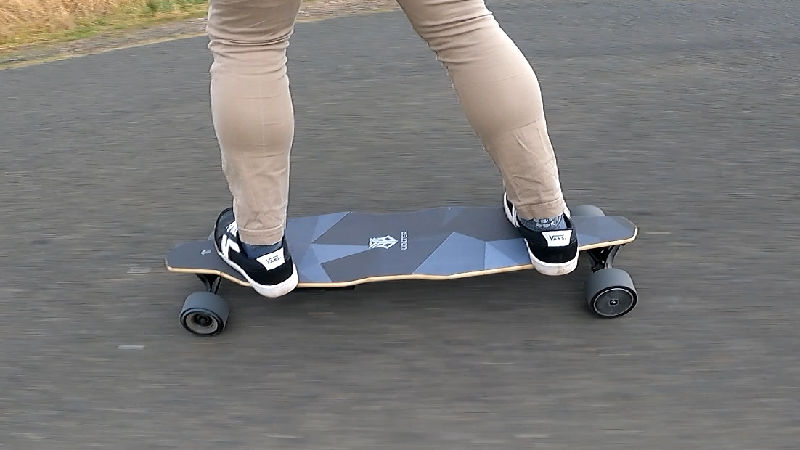
Braking Test
The braking on the Uditer 3 series is very gentle to say the least.
You really need to be on your game when riding at high speeds because it takes a long time to come to a complete stop.
If anything unexpected was to happen while you were riding in excess of 30kph (18mph) you’d be in a bit of trouble.
Just make sure you’re looking ahead and not riding at a pace that your brakes wouldn’t be able to stop you within a safe distance.
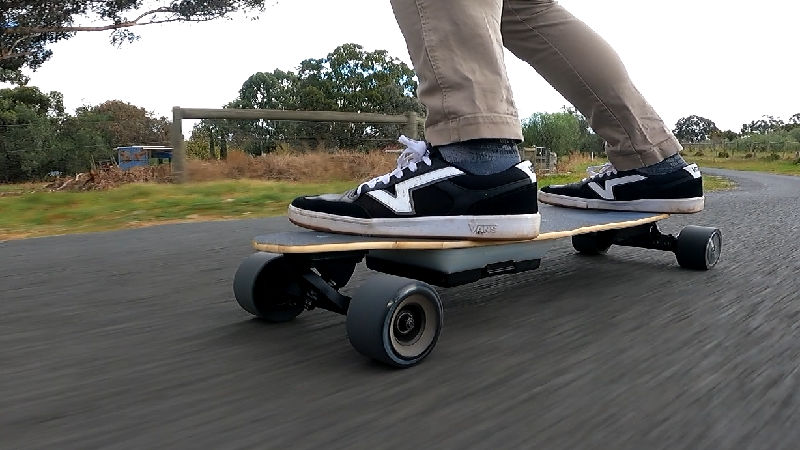
Hill Climb Test
The Uditer 3 is specced for a 30% hill grade.
Which I think is just a generic number all eskate companies slap on their eboards without really testing it.
Let’s take a look at the data for the Hill climb test.
It’s my new regular hill climb test location which has an average hill grade of 8% with the steepest section being 13%.
I enter the hill at around 22kph (13mph) then I floor the throttle.
It’s a slow incline and my speed doesn’t change all that much.
Until I enter the steepest section of the climb.
The grade jumps up to 13% and my speed drops down to 10kph (6mph).
It struggles for a bit then gets back up to 16kph (10mph) once the hill flattens slightly to 8%.
Remember, I’m 90kg so it’s expected that it should be harder to pull me up a hill.
That said, there is ZERO chance it will pull me up a 30% hill grade and I’d be interested to see just how light a rider needs to be in order to be able to climb a hill of that steepness on this eboard.

The Scooterboard
Uditer are very excited about their handlebar and how it gives riders the opportunity to turn their electric skateboard into a ‘scooterboard’.
So let’s take a look at it and see what all the hype is about.
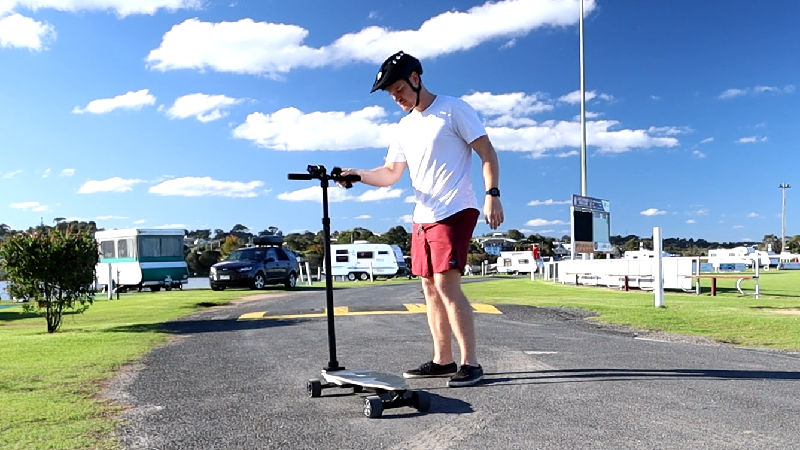
For starters, the installation is pretty straight forward.
You remove the remove the current bolts on the front truck and replace them with the extra long ones provided along with the handlebar.
You will have to cut holes in the griptape to mount the handlebar, so if you do decide to go back to just the regular skateboard after trying out the scooterboard, you’ll be left with odd holes at the nose.
Then you can screw the rest of the handle bar components together.
There’s two 3.5mm thread where you can mount any camera.
One at the top of the handlebar and one at the base.
Here’s where the entire design is flawed.
The deck is flexible, so whenever there is a slight bounce, from a crack or a bump, the board bends causing the handlebars go wild all over the place.
It’s really quite comical.
There are three things that make this an issue.
- You lose control of the handlebars when the bouncing occurs
- Naturally, when this bouncing occurs, you want to hold the handlebars steady. This puts tension on the deck at its weakest point between the trucks and the body of the deck. A deck snap right here is inevitable.
- The handlebar with the 3.5mm thread is aimed at providing vloggers the opportunity to set their camera on a ‘tripod’ like system so they have extra hands free.
- Well, A, that camera will be bobbing around not getting a single usable frame
- And B, all those spare hands you’re supposed to have, well you’be hanging onto the handlebars trying to keep this thing steady.

Lastly, when you’re riding with the handle bars, you still need to hang onto the remote.
So it’s either one hand on the handlebars or awkwardly holding the remote against the bars.
Both of which aren’t particularly safe.
It would have been really cool if they implemented a remote control into the actual handlebars themselves, or maybe like a transformable remote where the throttle pops out of the handheld remote and can be plugged into the handlebar.
I think there are opportunities for this ‘scooterboard’ to be a thing, but for now, this just isn’t it.
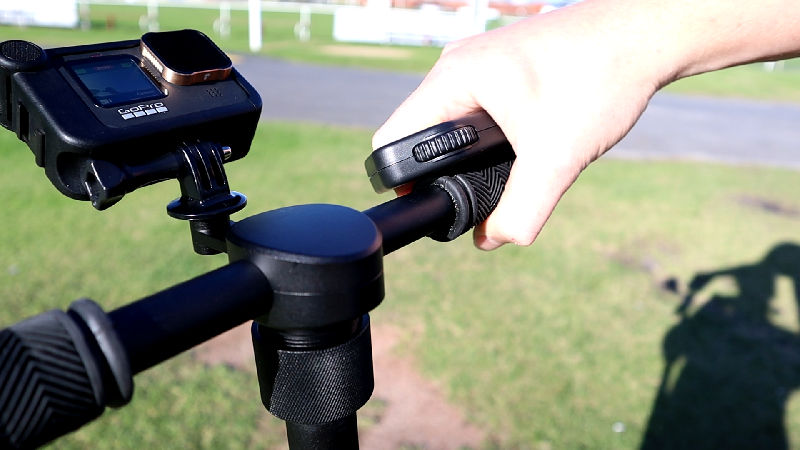
The Ride Experience
The Uditer boards are powered by a LingYi ESC which generally divides eskaters.
The Uditer 3 series has a 38” bamboo and fibreglass deck with a very slight concave.
It has standard griptape which hasn’t been applied symmetrically. And that kind of irks me.
I know it has nothing to do with the performance of the board, but it does signal to me the level of quality assurance they undertake on their products.
That leads me to the hardware. I don’t think it’s the best quality. The baseplates already had paint chipped off around where the bolts are when it arrived.
This is a shame for Uditer, because it’s only a perceived sense of quality. The hardware might be fine.

In fact, the trucks are surprisingly nice. They are 8” magnesium-alluminium alloy, so pretty standard.
But the interesting thing about these trucks is that I felt more comfortable on the deck when the trucks were a bit looser.
When I had them a tighter but not quite full lock, I had next to no turning capability. Not even for a side-to-side sway. This was unnerving because any shift in my body weight resulted in me just falling off because the board didn’t follow my movements.
When I did finally find my ideal settings for the trucks, the carving was great. I couldn’t get too deep of a carve, but I could get a nice and easy S-curve going on.
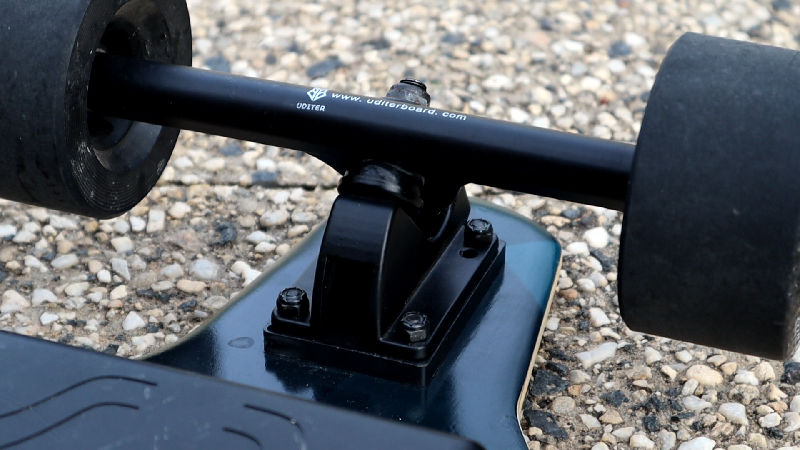
The 90mm 78A wheels are soft and grippy giving me plenty of confidence to take corners at decent speeds.
The rear wheels have a larger contact area than the front wheels which I think is what gives the eboard a sense of control around corners while maintining the carvability in the frontend.

The dual 500W hub motors have a nice amount of PU between them and the road which help to absorb some fo the vibrations from the road, but it’s the large riser pads that will be doing a lot of the vibration absorption
The battery spec is a 10S3P array of 18650 cells pumping out 328Wh.
That’s a decent size for this category of eboard.
It’s exciting to see that battery technology is fast becoming more affordable and we are starting to see bigger and better batteries in affordable electric skateboards.

The best thing about this battery and the eboard as a whole, is the remove able battery pack.
This is a simple system that works well enough.
It does look a bit like the old enclosures that DIYers used to use where they bolted a tupperware container to the bottom of their decks and stuffed all the electronics in there.
This solution is a little more elegant as there is a separate enclosure for the ESC and the big box is just the battery.
To take the battery out, all you need to do is pinch the tabs together and lift it out.
It is a heavy battery so you need to use a bit of force to get it out.
Then all you have to do is disconnect this cable.
You can charge the battery separately from the board which is so handy.
You can leave the board out in the garage and just take the battery inside to charge. Your wife/husband/family or whatever will thank you for this.

Also, the battery has a USB out so you can charge any of your USB powered devices such as your phone.
My experience with this one has been somewhat the same.
For the most part, it is fine. It accelerates and brakes smoothly and gently.
However, there is a slight amount of ‘dead space’ in the throttle and braking.
What I mean by this is, when you accelerate or brake, there is a few millimetres of movement in the thumbwheel before the motors engage.
I don’t know if I’m being too picky here or not, although, there is enough dead space for it to be noticeable.
After a while I did get used to it and I adjusted my riding style to suit. But it’s just something worth noting.
The other thing that had me concerned with this remote is a little more serious.
When you’re accelerating, even at full throttle, if you hit the mode button, the board will click over into the new mode and start accelerating, or decelerating if flicking from mode 4 back around to 1.
The way my hand naturally sits on the remote leaves my fingers hovering over those buttons.
On more than one occasion while out on a ride, I accidentally dropped into gear 1 when I usually ride in gear 4. That shutter of unknowingly decelerating was a shot to the confidence when riding on this board.
If you were a beginner, riding around in mode 2 then accidentally clicked over to mode 3 without realising or being prepared, the board would quickly accelerate throwing your balance off.
Some people like this feature, in fact, Exway offer it as an option in their app. But the default is you can only change modes when not accelerating and you have to switch it otherwise.
Am I being over cautious on this?

Another minor detail about the remote is that the odometer shows a speed which is 4-5kmh above what my actual speed was being measured on my watch.
I know that there are delays in GPS so I tested this over a space of 20 seconds. Plus I haven’t seen this level of discrepancy in other boards using this same testing method.
At the end of the ride, there aren’t any sound or vibration warnings to let you know that the battery is starting to run flat.
There possibly could be some beeps coming from the board, because I did hear some after I stepped off, but they are impossible to hear while you’re riding.
All eskate remotes really should have some kind of haptic feedback, because it is hard to hear beeps when riding.
So when you do come to the end of the ride, the acceleration just cuts out.
You gradually lose acceleration power and top speed as you near the end, but the cutoff still feels quite abrupt.
Thankfully, you do still have access to your brakes in the unlikely case that you’re riding down hill at the time the battery goes flat.
Final Thoughts
Overall, the Uditer W3 and S3 are interesting electric skateboards to say the least.
They have great range capabilities and the ability to quickly swap the battery means you can go for extended rides without having to stop somewhere to juice up.
I think the whole product is let down by trying to be something that it is not.
The implementation of the handlebar and its usability is clunky and truthfully, just not worth it.
Uditer has a unique opportunity here to develop this idea further and really perfect it. Because I think when it’s done right, it’ll be really cool but it’s just not quite there yet.
The rideability is easy and non-threatening which is fantastic for beginners, so long as you’re aware of the nuances of the remote control.
I’d recommend this board to someone who only cares about riding the farthest possible distance in one go.
That’s my Uditer W3 electric skateboard review. I hope I’ve helped make your search for the best electric skateboard a little easier.
Alternatives
WowGo 2S Pro
The WowGo 2S Pro is an amazingly comfortable electric skateboard that you could skate for hours.





